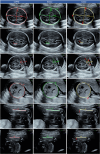Artificial intelligence assistance for fetal development: evaluation of an automated software for biometry measurements in the mid-trimester
- PMID: 38395822
- PMCID: PMC10885506
- DOI: 10.1186/s12884-024-06336-y
Artificial intelligence assistance for fetal development: evaluation of an automated software for biometry measurements in the mid-trimester
Abstract
Background: This study presents CUPID, an advanced automated measurement software based on Artificial Intelligence (AI), designed to evaluate nine fetal biometric parameters in the mid-trimester. Our primary objective was to assess and compare the CUPID performance of experienced senior and junior radiologists.
Materials and methods: This prospective cross-sectional study was conducted at Shenzhen University General Hospital between September 2022 and June 2023, and focused on mid-trimester fetuses. All ultrasound images of the six standard planes, that enabled the evaluation of nine biometric measurements, were included to compare the performance of CUPID through subjective and objective assessments.
Results: There were 642 fetuses with a mean (±SD) age of 22 ± 2.82 weeks at enrollment. In the subjective quality assessment, out of 642 images representing nine biometric measurements, 617-635 images (90.65-96.11%) of CUPID caliper placements were determined to be accurately placed and did not require any adjustments. Whereas, for the junior category, 447-691 images (69.63-92.06%) were determined to be accurately placed and did not require any adjustments. In the objective measurement indicators, across all nine biometric parameters and estimated fetal weight (EFW), the intra-class correlation coefficients (ICC) (0.843-0.990) and Pearson correlation coefficients (PCC) (0.765-0.978) between the senior radiologist and CUPID reflected good reliability compared with the ICC (0.306-0.937) and PCC (0.566-0.947) between the senior and junior radiologists. Additionally, the mean absolute error (MAE), percentage error (PE), and average error in days of gestation were lower between the senior and CUPID compared to the difference between the senior and junior radiologists. The specific differences are as follows: MAE (0.36-2.53 mm, 14.67 g) compared to (0.64- 8.13 mm, 38.05 g), PE (0.94-9.38%) compared to (1.58-16.04%), and average error in days (3.99-7.92 days) compared to (4.35-11.06 days). In the time-consuming task, CUPID only takes 0.05-0.07 s to measure nine biometric parameters, while senior and junior radiologists require 4.79-11.68 s and 4.95-13.44 s, respectively.
Conclusions: CUPID has proven to be highly accurate and efficient software for automatically measuring fetal biometry, gestational age, and fetal weight, providing a precise and fast tool for assessing fetal growth and development.
Keywords: Artificial intelligence; Biometry measurement; Fetal growth and development.
© 2024. The Author(s).
Conflict of interest statement
The authors declare no competing interests.
Figures






References
-
- Salomon L, Alfirevic Z, Berghella V, Bilardo C, Chalouhi G, Costa FDS, Hernandez-Andrade E, Malinger G, Munoz H, Paladini D, et al. Isuog practice guidelines (updated): performance of the routine mid-trimester fetal ultrasound scan. Ultrasound in obstetrics & gynecology: the official journal of the International Society of Ultrasound in Obstetrics and Gynecology. 2022;59(6):840–856. doi: 10.1002/uog.24888. - DOI - PubMed
-
- Bihoun B, Zango SH, Traore-Coulibaly M, Valea I, Ravinetto R, Van Geertruyden J-P, D’Alessandro U, Tinto H, Robert A. Fetal biometry assessment with intergrowth 21st’s and Salomon’s equations in rural Burkina Faso. BMC pregnancy and childbirth. 2020;20:1–12. doi: 10.1186/s12884-020-03183-5. - DOI - PMC - PubMed
MeSH terms
LinkOut - more resources
Full Text Sources

